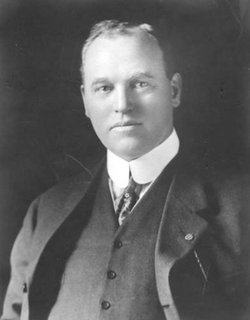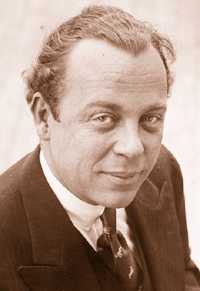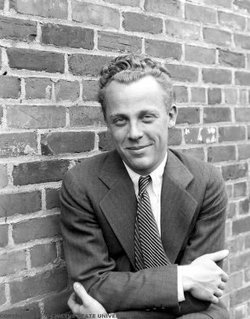<Back to Index>
- Automobile Pioneer Horace Elgin Dodge, Sr., 1868
- Novelist Henri Barbusse, 1873
- Colonel of the Continental Army Seth Warner, 1743
PAGE SPONSOR



Horace Elgin Dodge, Sr. (May 17, 1868 – December 10, 1920) was an American automobile manufacturing pioneer and co-founder of Dodge Brothers Company.
He was born in Niles, Michigan, on May 17, 1868. His father owned a foundry and machine shop, Horace Dodge and his elder brother John Francis Dodge were inseparable as children and as adults. In 1886, the Dodge brothers moved to Detroit, Michigan, where they took jobs at a boiler maker plant. In 1894 they went to work as machinists at the Dominion Typograph Company across the Detroit River in Windsor, Ontario.
In 1896, Horace Dodge married Anna Thompson, a Scottish immigrant born in Dundee. The couple had a son, Horace Jr., and a daughter, Delphine. Thompson would later marry actor Hugh Dillman after the death of Dodge.
While
John Dodge was the sales oriented managerial type, brother Horace was a
gifted mechanic and inveterate tinkerer. Using a dirt - proof ball
bearing Horace invented and patented, in 1897 John arranged a deal for
them to join with a third party investor to manufacture bicycles.
Within a few years, they sold the business and in 1900 used the
proceeds of the sale to set up their own machine shop in Detroit.
During their first year in business the Dodge brothers' company began
making parts for the automobile industry. In 1902, they won a contract to build transmissions for the Olds Motor Vehicle Company upon
which they built a solid reputation for quality and service. However,
the following year they turned down a second contract from Olds
(Oldsmobile) to retool their plant to build engines for Henry Ford in a deal that included a share position in the new Ford Motor Company. By 1910, Horace Dodge and his brother were so successful they built a new plant in Hamtramck, Michigan. For
ten years, the Dodge brothers' company were suppliers to Ford and John
Dodge worked as vice president of the Ford company. In 1913 he left
Ford to devote his energies full time to produce a Dodge automobile.
They began building motor trucks, ambulances and other vehicles for the United States military during the arms buildup for World War I and
in October 1917 they produced their first commercial car. At war's end,
their company manufactured and marketed both cars and trucks. Regardless
of their wealth and growing influence in the business community,
because of the brothers' crude manners and aggressive conduct, they
were regarded as socially unacceptable by most of the well - heeled elite
of Detroit. In 1912, Horace Dodge built a red sandstone mansion in Grosse Pointe. Calling it Rose Terrace, the huge home with formal gardens and boat dock overlooked Lake St. Clair. This was replaced by a second Rose Terrace,
constructed in the 1930s by Mrs. Dodge and her second husband, that
architectural historian W. Hawkins Ferry has described the mansion as
"unquestionably Grosse Pointe's most regal residence." In addition to
Rose Terrace, the Dodges acquired a large winter estate in Palm Beach, Florida. Horace's wife Anna had studied music and
through that they would be accepted as part of the upper crust of the
city's social order. Horace and Anna Dodge became major benefactors of
the new Detroit Symphony Orchestra and would play a key role in the construction of Orchestra Hall. A speedboat and yachting enthusiast,
Horace Dodge's keen interest in the vessel's engines led him to
establish a marine division as part of their automotive business. He
purchased several motor yachts, each larger and more luxurious than the previous. The last, named the Delphine for
his daughter, was a 257.8 - foot (78.6 m) vessel commissioned in
1920 that was only completed after his passing. In the ensuing years
the yacht experienced a sinking, a run onto rocks, and service as a United States Navy patrol boat during World War II. The Delphine passed through the hands of several owners and after major refurbishing it sails the Mediterranean today as a luxury charter. Great grandson is film producer Johnny Dodge. In 1919, Henry Ford bought out the Dodge brothers' shareholdings in Ford Motor Company for $25 million. In January 1920, Horace's brother, John, died from the Spanish flu. He was interred in the family's Egyptian style mausoleum in Detroit's Woodlawn Cemetery guarded by two Sphinx statues. Having also contracted the flu that December, Horace also died from complications resulting in pneumonia and cirrhosis of the liver at the age of 52. He was interred with his brother in the same mausoleum. His widow outlived him by fifty years. In 1925, Horace and John Dodge's widows sold their automobile business to Dillon Read investment bankers for
$146 million. Upon her death in 1970, Anna Thompson Dodge left a sum to
the City of Detroit for the construction of the Horace E. Dodge and Son
Memorial Fountain. Horace E. Dodge, Jr. died in 1963 at age 63. The fountain was designed by sculptor Isamu Noguchi and opened in 1978 as part of the city's Hart Plaza.